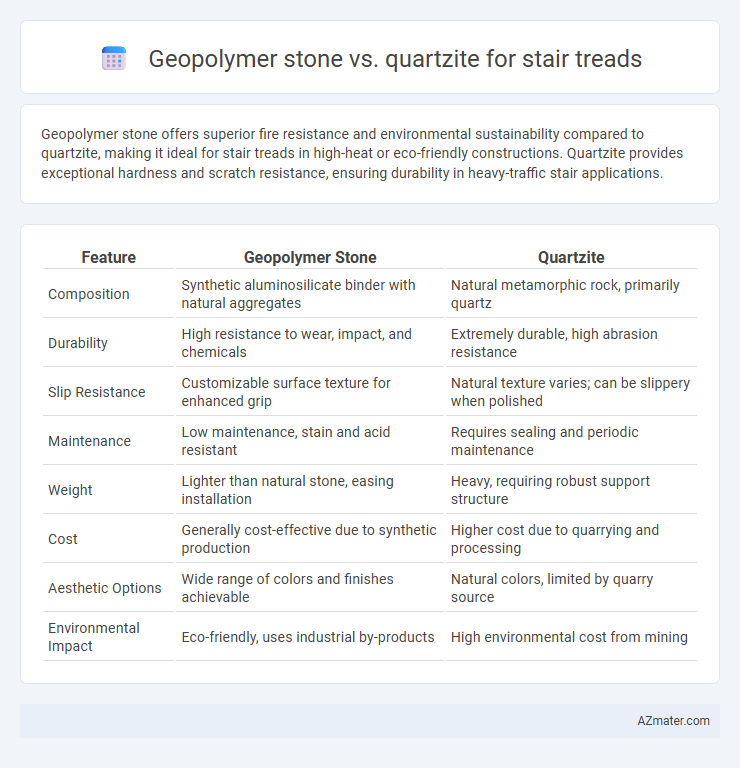Geopolymer stone offers superior fire resistance and environmental sustainability compared to quartzite, making it ideal for stair treads in high-heat or eco-friendly constructions. Quartzite provides exceptional hardness and scratch resistance, ensuring durability in heavy-traffic stair applications.
Table of Comparison
| Feature | Geopolymer Stone | Quartzite |
|---|---|---|
| Composition | Synthetic aluminosilicate binder with natural aggregates | Natural metamorphic rock, primarily quartz |
| Durability | High resistance to wear, impact, and chemicals | Extremely durable, high abrasion resistance |
| Slip Resistance | Customizable surface texture for enhanced grip | Natural texture varies; can be slippery when polished |
| Maintenance | Low maintenance, stain and acid resistant | Requires sealing and periodic maintenance |
| Weight | Lighter than natural stone, easing installation | Heavy, requiring robust support structure |
| Cost | Generally cost-effective due to synthetic production | Higher cost due to quarrying and processing |
| Aesthetic Options | Wide range of colors and finishes achievable | Natural colors, limited by quarry source |
| Environmental Impact | Eco-friendly, uses industrial by-products | High environmental cost from mining |
Introduction to Geopolymer Stone and Quartzite Stair Treads
Geopolymer stone stair treads are engineered from industrial byproducts like fly ash and metakaolin, offering high durability and environmental sustainability. Quartzite stair treads, formed from natural sandstone metamorphosed by heat and pressure, provide exceptional hardness and natural aesthetics. Both materials excel in wear resistance and slip prevention, making them ideal choices for high-traffic stair applications.
Composition and Material Properties
Geopolymer stone is composed primarily of aluminosilicate materials activated by alkaline solutions, resulting in a durable and heat-resistant composite ideal for stair treads. Quartzite, a natural metamorphic rock mainly consisting of quartz, offers exceptional hardness and scratch resistance, making it a preferred choice for high-traffic stair applications. The chemical inertness and low porosity of geopolymer stone enhance its moisture resistance, while quartzite's inherent crystalline structure provides superior compressive strength and long-term durability.
Aesthetic Appeal and Design Flexibility
Geopolymer stone offers a highly customizable aesthetic appeal with its ability to mimic natural stone textures and incorporate diverse colors, making it ideal for unique stair tread designs. Quartzite provides a luxurious, natural stone look with consistent grain patterns and subtle color variations, enhancing classic or modern stair aesthetics. The design flexibility of geopolymer stone surpasses quartzite due to its molded fabrication process, allowing for intricate shapes and seamless integration in complex architectural stair projects.
Durability and Wear Resistance
Geopolymer stone offers exceptional durability due to its synthetic composition, providing high resistance to abrasion and chemical damage ideal for stair treads in high-traffic areas. Quartzite, a natural metamorphic rock, is renowned for its superior hardness and wear resistance, making it one of the most durable options against scratches and impact. When comparing durability and wear resistance, quartzite generally outperforms geopolymer stone in natural toughness, while geopolymer stone excels in customizable strength and consistent quality.
Slip Resistance and Safety Considerations
Geopolymer stone for stair treads offers superior slip resistance due to its textured surface and higher coefficient of friction compared to quartzite, greatly reducing the risk of slips and falls. Quartzite, while harder and more durable, can be highly polished, making it potentially slippery when wet or in high-traffic areas, thus requiring additional anti-slip treatments. Safety considerations prioritize materials like geopolymer stone that naturally provide traction and reduce maintenance needs for slip prevention on stairs.
Environmental Impact and Sustainability
Geopolymer stone stair treads offer a significantly lower carbon footprint compared to quartzite due to their use of industrial byproducts like fly ash or slag, reducing waste and reliance on natural quarrying. Quartzite extraction involves substantial energy consumption and habitat disruption, leading to greater environmental degradation and resource depletion. Choosing geopolymer stone promotes sustainability through recycled materials and reduced greenhouse gas emissions, aligning with green building standards.
Installation Process and Maintenance
Geopolymer stone stair treads offer a more straightforward installation process due to their lightweight nature and uniform composition, allowing for easier cutting and fitting compared to the denser and harder quartzite. Maintenance for geopolymer stone is typically lower as it resists stains and requires only regular cleaning with mild detergents, whereas quartzite stair treads, with their natural mineral composition, demand periodic sealing to maintain their durability and appearance. Both materials provide strong, durable surfaces, but the ease of installation and less intensive upkeep make geopolymer stone a more user-friendly choice for stair treads.
Cost Comparison and Budget Considerations
Geopolymer stone offers a cost-effective alternative to quartzite for stair treads due to its lower raw material and manufacturing expenses, typically costing 30-50% less. Quartzite, known for its durability and natural beauty, commands a higher price but may incur additional installation and maintenance costs over time. Budget considerations should weigh initial savings of geopolymer stone against the long-term value and lifespan benefits provided by quartzite in high-traffic stair applications.
Performance in Indoor vs Outdoor Applications
Geopolymer stone offers superior chemical and weather resistance, making it highly durable for outdoor stair treads exposed to varying temperatures and moisture. Quartzite, prized for its natural hardness and abrasion resistance, excels in indoor applications where foot traffic is heavy but environmental conditions are controlled. Both materials provide excellent performance, yet geopolymer stone's enhanced UV stability and freeze-thaw resilience give it an edge in exterior settings, while quartzite's aesthetic appeal and polish retention suit indoor staircases.
Choosing the Right Material for Your Stair Tread
Geopolymer stone offers exceptional durability and eco-friendly properties, making it a strong candidate for stair treads in sustainable construction projects. Quartzite, known for its natural hardness and resistance to abrasion, provides a luxurious appearance and long-lasting performance ideal for high-traffic areas. Selecting between geopolymer stone and quartzite depends on priorities such as environmental impact, budget, and desired aesthetic, with geopolymer favoring sustainability and quartzite excelling in natural beauty and toughness.

Infographic: Geopolymer stone vs Quartzite for Stair tread
 azmater.com
azmater.com